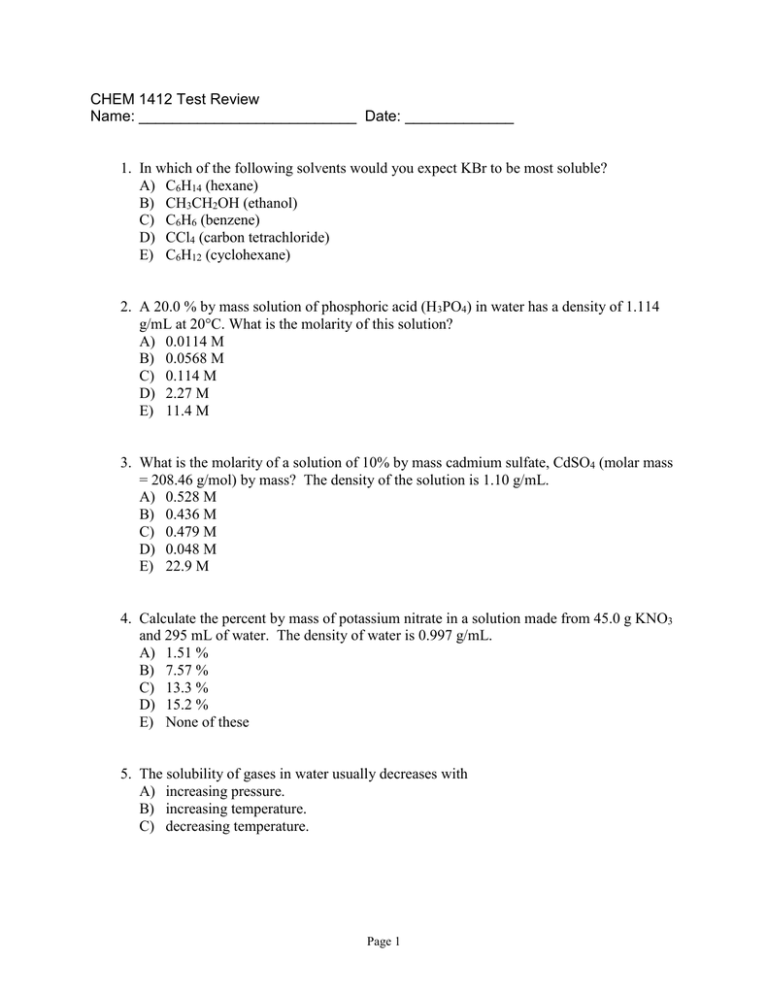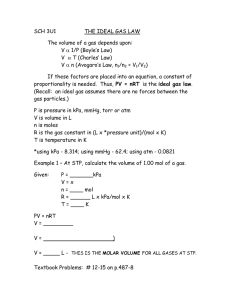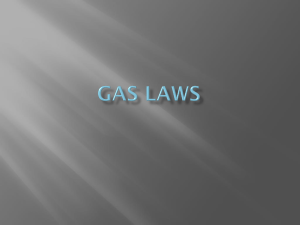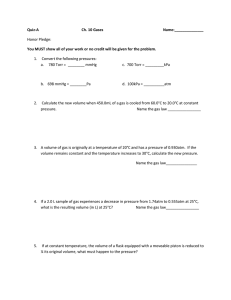Exam 1 review.pdf.doc
advertisement

CHEM 1412 Test Review Name: __________________________ Date: _____________ 1. In which of the following solvents would you expect KBr to be most soluble? A) C6H14 (hexane) B) CH3CH2OH (ethanol) C) C6H6 (benzene) D) CCl4 (carbon tetrachloride) E) C6H12 (cyclohexane) 2. A 20.0 % by mass solution of phosphoric acid (H3PO4) in water has a density of 1.114 g/mL at 20°C. What is the molarity of this solution? A) 0.0114 M B) 0.0568 M C) 0.114 M D) 2.27 M E) 11.4 M 3. What is the molarity of a solution of 10% by mass cadmium sulfate, CdSO4 (molar mass = 208.46 g/mol) by mass? The density of the solution is 1.10 g/mL. A) 0.528 M B) 0.436 M C) 0.479 M D) 0.048 M E) 22.9 M 4. Calculate the percent by mass of potassium nitrate in a solution made from 45.0 g KNO3 and 295 mL of water. The density of water is 0.997 g/mL. A) 1.51 % B) 7.57 % C) 13.3 % D) 15.2 % E) None of these 5. The solubility of gases in water usually decreases with A) increasing pressure. B) increasing temperature. C) decreasing temperature. Page 1 6. Oxygen gas makes up 21 % of the atmosphere by volume. What is the solubility of O2(g) in water at 25°C if the atmospheric pressure is 741 mmHg? The Henry's law constant for oxygen gas at 25°C is 1.3 10–3 mol/L·atm. A) 2.7 10–4 M B) 1.3 10–3 M C) 6.2 10–3 M D) 9.6 10–3 M E) 0.96 M 7. The vapor pressure of water at 20°C is 17.5 mmHg. What is the vapor pressure of water over a solution prepared from 2.00 102 g of sucrose (C12H22O11) and 3.50 102 g water? A) 0.51 mmHg B) 16.0 mmHg C) 17.0 mmHg D) 18.0 mmHg E) 19.4 mmHg 8. What is the freezing point of a solution that contains 10.0 g of glucose (C6H12O6) in 100. g of H2O? Kf for water is 1.86°C/m. A) –0.186°C B) +0.186°C C) –0.10°C D) +0.10°C E) –1.03°C 9. Which of the following aqueous solutions has the highest boiling point? Kb for water is 0.52°C/m. A) 0.2 m KCl B) 0.2 m Na2SO4 C) 0.2 m Ca(NO3)2 D) A and B. E) B and C. 10. What is the osmotic pressure of a solution prepared from 13.7 g of the electrolyte HCl and enough water to make 0.500 L of solution at 18°C? A) 0.55 atm B) 1.10 atm C) 8.95 atm D) 17.9 atm E) 35.9 atm Page 2 11. Chlorine dioxide reacts in basic water to form chlorite and chlorate according to the following chemical equation: 2ClO2(aq) + 2OH–(aq) ClO2–(aq) + ClO3–(aq) + H2O(l) Under a certain set of conditions, the initial rate of disappearance of chlorine dioxide was determined to be 2.30 x 10–1 M/s. What is the initial rate of appearance of chlorite ion under thos same conditions? A) 5.75 x 10–2 M/s B) 1.15 x 10–1 M/s C) 2.30 x 10–1 M/s D) 4.60 x 10–1 M/s E) 9.20 x 10–1 M/s 12. The reaction A + 2B products has been found to have the rate law, rate = k[A] [B]2. While holding the concentration of A constant, the concentration of B is increased from x to 3x. Predict by what factor the rate of reaction increases. A) 3 B) 6 C) 9 D) 27 E) 30 13. Use the following data to determine the rate law for the reaction shown below. 2NO + H2 N2O + H2O Expt. # [NO]0 [H2]0 Initial rate 1 0. 21 0.065 1.46 M/min 2 0.021 0.260 1.46 M/min 3 0.042 0.065 5.84 M/min A) rate = k[NO] B) rate = k[NO]2 C) rate = k[NO][H2] D) rate = k[NO]2[H2] E) rate = k[NO]2[H2]2 14. At 25°C the rate constant for the first-order decomposition of a pesticide solution is 6.40 10–3 min–1. If the starting concentration of pesticide is 0.0314 M, what concentration will remain after 62.0 min at 25°C? A) 1.14 10–1 M B) 47.4 M C) –8.72.0 M D) 2.11 10–2 M E) 2.68 10–2 M Page 3 15. The activation energy of a certain uncatalyzed reaction is 64 kJ/mol. In the presence of a catalyst, the Ea is 55 kJ/mol. How many times faster is the catalyzed than the uncatalyzed reaction at 400°C? Assume that the frequency factor remains the same. A) 5.0 times B) 1.16 times C) 15 times D) 2.0 times E) 0.2 times 16. With respect to the figure below, which choice correctly identifies all the numbered positions? 17. For the reaction X2 + Y + Z XY + XZ, it is found that the rate equation is rate = k [X2][Y]. Why does the concentration of Z have no effect on the rate? A) The concentration of Z is very small and the others are very large. B) Z must react in a step after the rate determining step. C) Z is an intermediate. D) The fraction of molecules of Z that have very high energies is zero. E) The activation energy for Z to react is very high. Page 4 18. Complete the following statement: A catalyst A) increases the activation energy. B) alters the reaction mechanism. C) increases the average kinetic energy of the reactants. D) increases the concentration of reactants. E) increases the collision frequency of reactant molecules. 19. The activation energy for the following reaction is 60. kJ/mol. Sn2+ + 2Co3+ Sn4+ + 2Co2+ By what factor (how many times) will the rate constant increase when the temperature is raised from 10°C to 28°C? A) 1.002 B) 4.6 C) 5.6 D) 2.8 E) 696 20. A certain first-order reaction A B is 25% complete in 42 min at 25°C. What is the half-life of the reaction? A) 21 min B) 42 min C) 84 min D) 20 min E) 101 min Page 5 Answer Key 1. 2. 3. 4. 5. 6. 7. 8. 9. 10. 11. 12. 13. 14. 15. 16. 17. 18. 19. 20. B D A C B A C E E E B C B D A D B B B E Page 6







